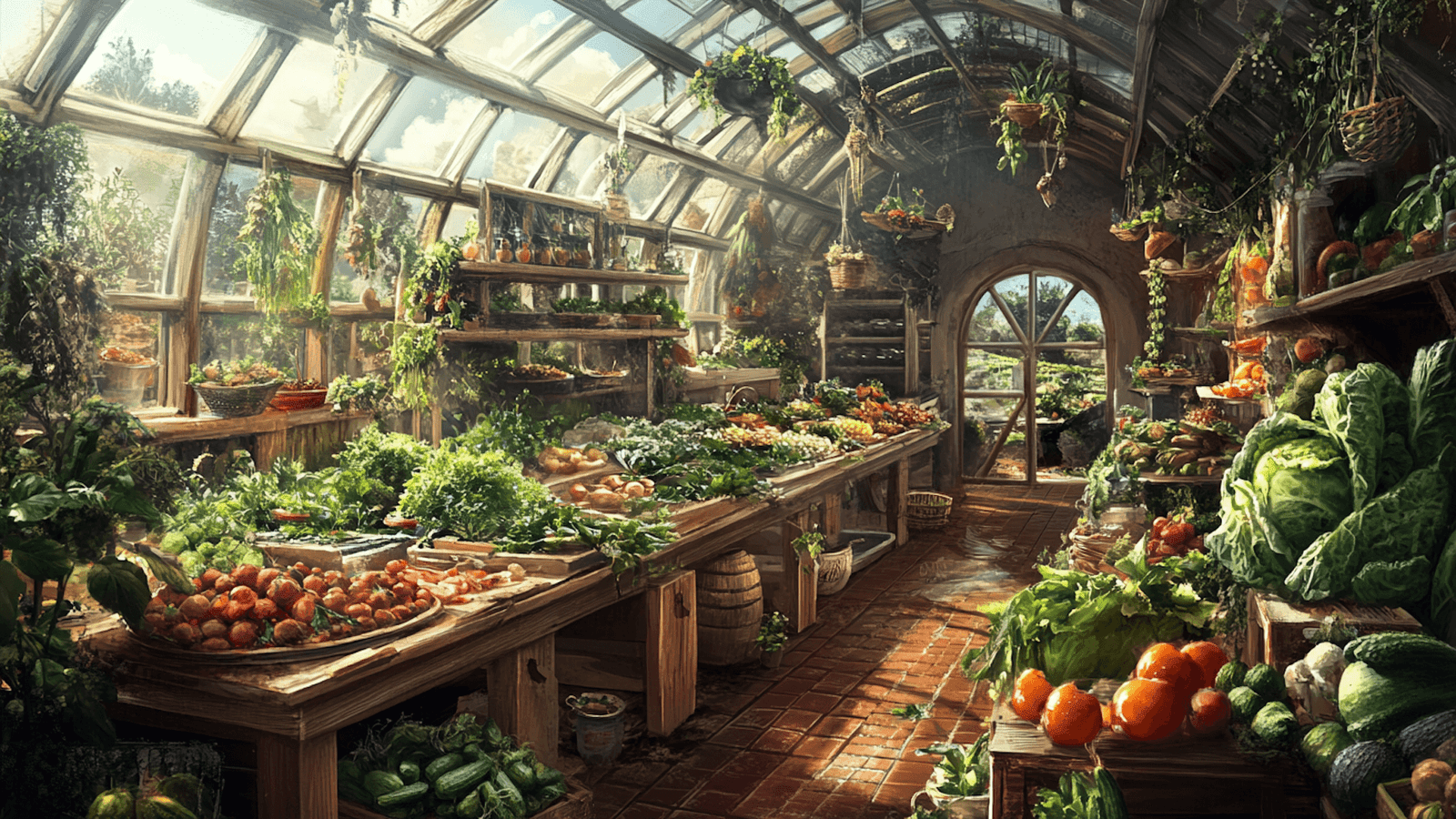
VENICE BIENNALE 2025
seeding global collaborative intelligence
Science and art belong to the whole world, and before them vanish the barriers of nationality.
Johann Wolfgang von Goethe
VENICE BIENNALE 2025, with its theme Intelligens, a Latin word that contains the word “gens” (“people”), is a call to action to 8+ billion of us to harness our collaborative intelligence (C-IQ) to address the grave global crises humanity faces.
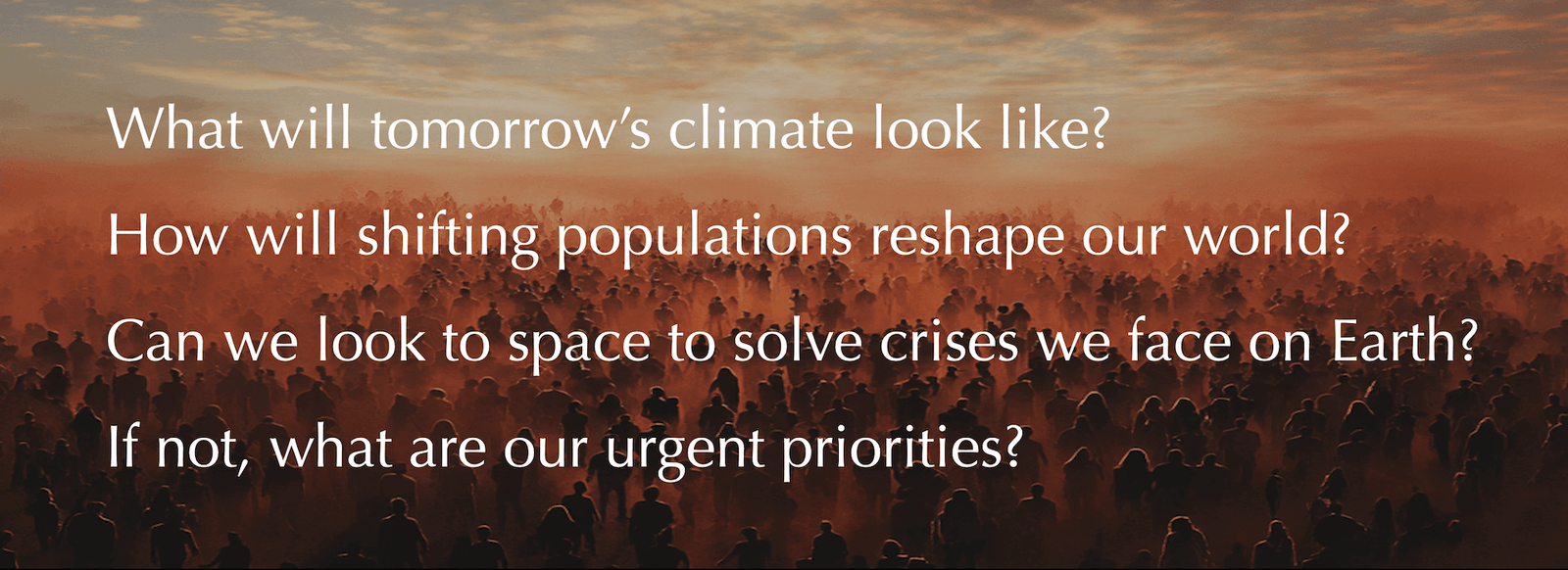
Mission
To light a torch and lead by example
The exhibition shows our co-dependency for survival. To adapt to climate change, “architecture needs to draw on all forms of intelligence. . . to reach out across generations and across disciplines – from the hard sciences to the arts. In a time of adaptation, architecture must rethink authorship and become more inclusive, learning from science.”
From the VENICE BIENNALE 2025 team: “Intelligens serves as a dynamic laboratory, uniting experts across various forms of intelligence. For the first time, the Exhibition features over 750 participants: architects and engineers, mathematicians and climate scientists, philosophers and artists, chefs and coders, writers and woodcarvers, farmers and fashion designers . . . Adaptation demands inclusivity and collaboration. Curating on such a large scale required a fundamental shift in approach.”
A public program, GENS, will host a chorus of events and conversations, engaging audiences, both large and small, and a range of physical experiences at the Biennale will start the process of raising questions.
Corderie dell’Arsenale visitors confront a stark reality: global temperatures rise as global populations fall. Their spatial experience includes artificial floods and searing air vortices. UK Astronomer Royal Martin Rees, co-founder of the Centre for the Study of Existential Risk (CSER) at Cambridge University, in his essay for the catalog reminds us that space exploration is no salvation.
Designer: Niklas Bildstein Zaar. Graphic Designer: Bänziger Hug Kasper Florio. Climate Scholars: Sonia Seneviratne, David Bresch. German climate engineering office Transsolar. Environmental Historian Daniel A. Barber.

Lessons – from War to Microbes
From the Ukraine comes an exhibit using computer vision to map and rebuild cities destroyed by war and a haunting reminder that technology is not neutral—it can be a tool for rebuilding or a means of destruction. Contributors: Kateryna Lopatiuk, Herman Mitish, Roman Puchko, Oleksandr Sirous, and Orest Yaremchuk, provocateurs who exemplify ARQ [Arts Raising Questions].
The Other Side of the Hill shows what we must learn from the microbial communities that we depend on for our survival. Designers: physicist Geoffrey West, biologist Roberto Kolter, architectural theorists Beatriz Colomina and Mark Wigley, artist Patricia Urquiola. Some of the many questions raised are shown in the image below.

Innovation as a Core Theme
Matter Makes Sense explores future construction materials – bioconcrete, banana fiber, graphene, highlighting dozens of projects from all over the world. Designers: Professors Ingrid Paoletti and Stefano Capolongo, Nobel laureate Konstantin Novosëlov, scenographer Margherita Palli Rota. A related project explores how Japanese joinery techniques, fused with AI, can turn irregular timber into structural material. Designers: Kengo Kuma & Associates, Sekisui House – Kuma Lab & Iwasawa Lab (both at the University of Tokyo), and Ejiri Structural Engineers.
Circular Economy Manifesto was produced by Biennale Architettura with Arup and the Ellen MacArthur Foundation, with bold goals to reduce waste and promote material reuse at the Biennale Architettura itself and a research handbook by teams from China and Italy: Archi-Neering-Design, Massimiliano Condotta and Valeria Tatano – Università IUAV of Venice, Jin Arts, Pills, Róng Design Library, and Typo-D.
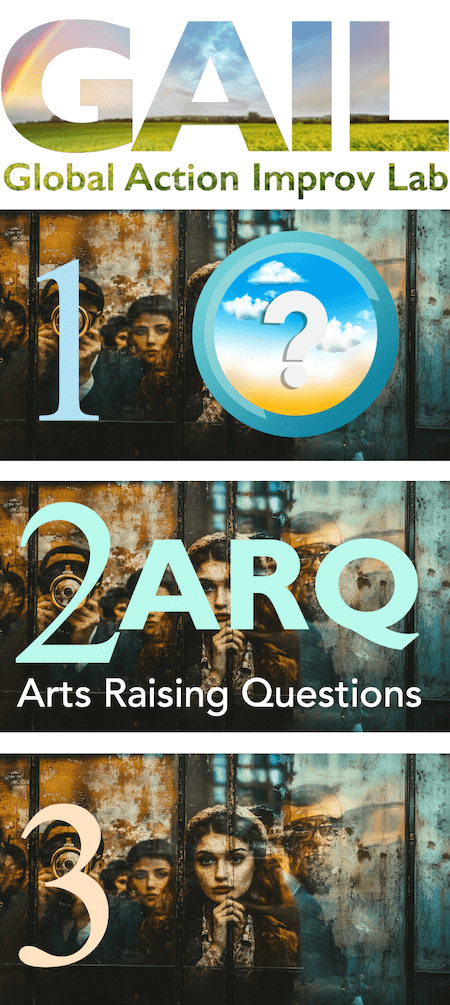
A.I. empowers human creatives, raising questions to guide us toward constructive futures. GAIL takes the Venice Biennale theme intelligens online to harness our collaborative intelligence, inspiring a global network to address grave challenges that we face in today’s world. Sign up for an online workshop at a time that suits your location. Bring burning questions. Learn to use new A.I. tools to communicate your questions to the world.
Join the GAIL ARQ [Arts Raising Questions] online network. Even if you don’t have a question, join the ongoing exchange of ideas. Comment on the questions others raise in a safe, online community of people who care about our world. Post with links to your profile and other work. Or, if you’re in an authoritarian regime, post with a pseudonym.The innovation message of the Venice Biennale reaches a global network of creatives. Or join KidParLe [Kids and Parents Learning] a portal focusing on content for this key group, who are the future for our world.
crowdsourcing human ingenuity
Ask a question that can change our world by
- making people wonder
- sparking debate and critical thinking
- igniting ingenuity and innovation
Use A. I. to generate an image that
- brings your question to life so that it engages others
- attracts creatives, crowdsourcing diverse human ideas and opinions to
- POW! [Power Our World]
Use A.I. to turn your image into a film clip. Win a SPARK Award to turn your seed into an app, game, or story to be exhibited online.

GAIL takes the timely Venice Biennale theme intelligens online to harness our collaborative intelligence, inspiring a global network to address grave challenges that we face in today’s world. Sign up for an online workshop at a time that suits your location. Bring burning questions. Learn to use new A.I. tools to communicate your questions to the world.
Join the GAIL ARQ [Arts Raising Questions] online network. Even if you don’t have a question, join the ongoing exchange of ideas. Comment on the questions others raise in a safe, online community of people who care about our world. Post with links to your profile and other work. Or, if you’re in an authoritarian regime, post with a pseudonym.
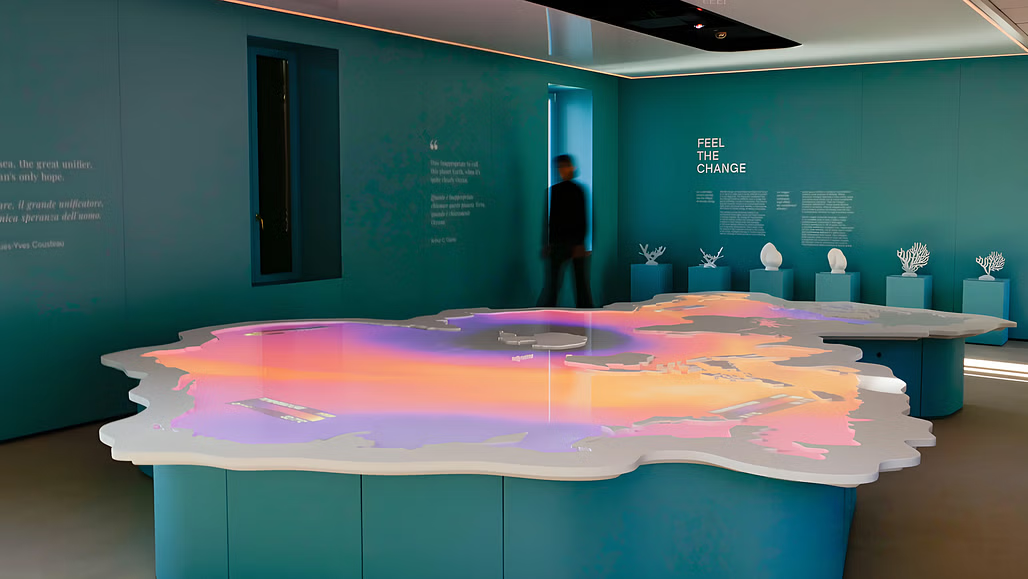
Venice as a Living Lab
Carlo Ratti Associates, architects and urban designers, have led a range of revitalization projects, ranging from Sea Beyond: Ocean Literacy Centre, image above, to revitalizing heritage Italian sites.
Venice, beyond hosting the Biennale 2025, is one of the most imperiled cities on Earth in the face of a changing climate and is becoming a living laboratory with installations, prototypes, and experiments scattered across the Giardini, the Arsenale and other neighborhoods.
Redesigning how Venice relates to its canals entails exploring sustainable aquatic mobility and transforming the waters of Venice by purifying the canals to create the best espresso in Italy, showing how transformation can overcome environmental challenges and impact daily life. Designers: Norman Foster Foundation, Michael Mauer; Ragnar Schulte, Porsche; Miguel Kreisler, Empty+Bau; Christopher Hornzee-Jones, Aerotrope will Diller Scofidio + Renfro; Aaron Betsky, Natural Systems Utilities; SODAI, Chef Davide Oldani.

VENICE BIENNALE 2025 – 2026 and beyond
VENICE BIENNALE 2025 can seed next steps for future years, as shown in the diagram below.
- As Chair of the Venice Biennale 2025, Carlo Ratti is growing a global network of thought leaders, enabling the VENICE BIENNALE 2025 to seed global innovation for future generations. VENICE BIENNALE 2025 is ideally timed for launch of an online gallery ARQ [Arts Raising Questions] to seed critical thinking about our options, unleash our collaborative intelligence, galvanizing
global action, continuing to grow and evolve after the close of the 2025 Biennale, engaging humanity’s global intelligence for the future of life on this planet. The arts can seed coalition building on hard problems (e.g. climate change) when authoritarian regimes block science. The 2025 ARQ [Art Raising Questions] online gallery launches during the Venice Biennale, planting seeds for 2026 and beyond.
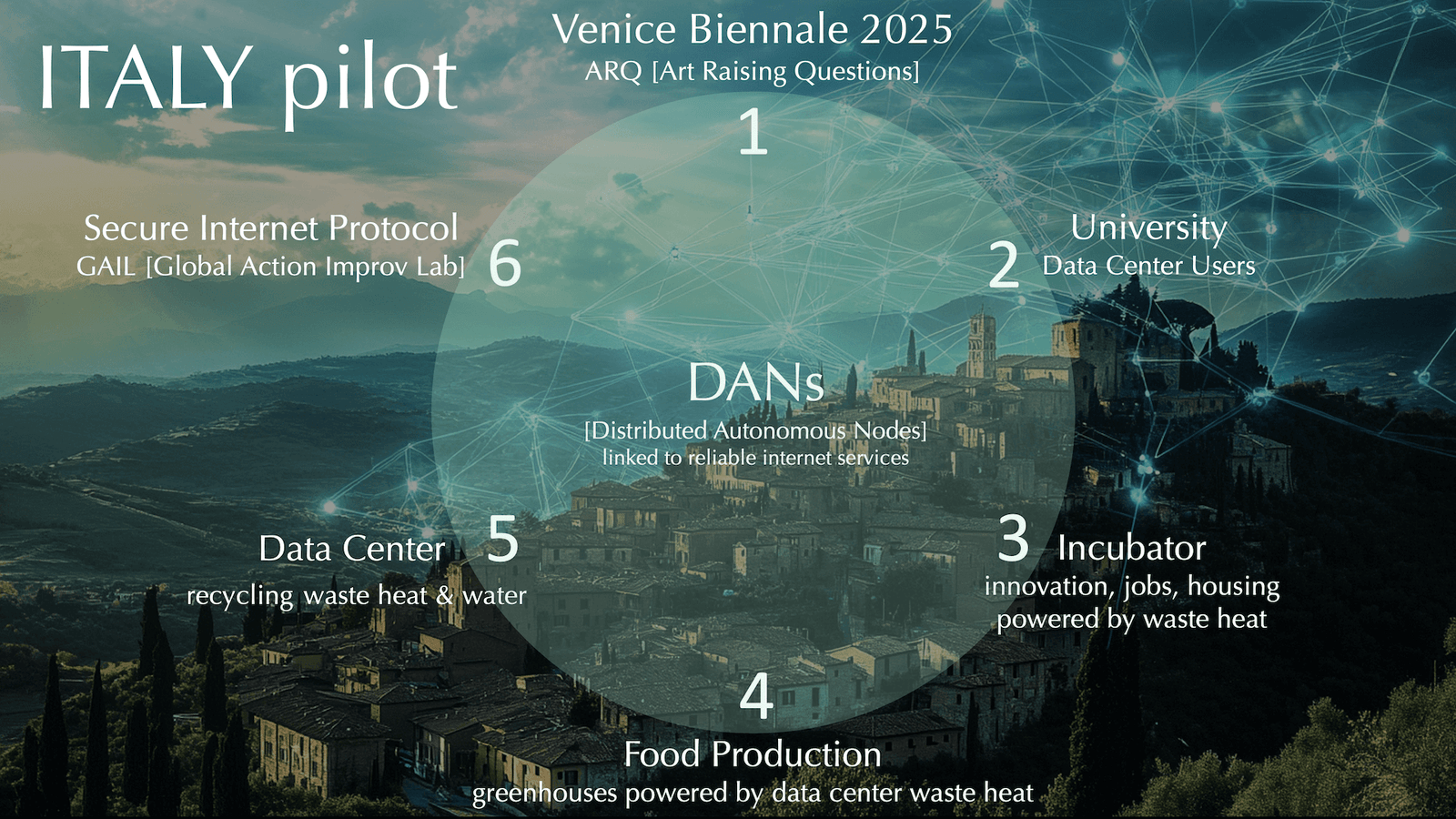
2. Revival of picturesque hill towns, like those in the foothills of the Alps between Milan and Turin where textile-producers near Biella make high quality designer fabrics, could be an Italian model to translate and adapt in other places in the world. Over three decades these towns have been shrinking because of automation and outsourced production to other countries, leaving villages filled with beautiful houses, but few inhabitants. Large factories lie empty. Recovery of these heritage towns and their factories could support arts, culture, and the environment.
Digital nomads, who make a living working remotely, also need offline community with a high quality of life close to nature and to be near international airports in Milan and Turin, both large cosmopolitan cities with outstanding universities. Towns in the region near Biella can be revived to thrive with beautifully designed, low-cost, high-quality housing. Empty factories can be repurposed as data centers to serve the needs of the online world, using waste heat from the data centers to heat homes in the neighboring community and greenhouses producing food.
Universities and Data Centers can also drive Urban Revitalization Projects. Example: Polytechnic University of Torino (30+k students), the oldest Italian public technical university in Italy, is already part of CINECA, which serves public universities in Italy, and could support an innovation network. A distinguished alumnus of the Polytechnic University of Torino, Carlo Ratti Associates (CRA), HQ in Torino, is designing a project to revitalize large military barracks in Torino. Beyond Torino, the concept of revitalizing 250 Italian hill towns was featured by publications internationally:
- 250 or more Hill Towns for revitalization
- Forbes on Italy’s hill town revitalization program
- Smithsonian
This concept needs economic stimulus. The Venice Biennale 2025 can stimulate Italian hill town revitalization after the Biennale, attracting and celebrating a global network of architects and artists – provocateurs raising questions toward a more sustainable world. A Data Center can support online planning where proposed projects are compared and assessed through simulations – digital twins.
3. Innovation and high tech incubator(s) for start-ups can be coupled with training for jobs, community services, and lifelong learning. Local parameters for a right-sized data center define design to serve a world class university, local innovators, and nearby hill town revitalization as university data users define how a data center-driven redevelopment project can also serve their needs.
4. Food production needs and opportunities vary by location, climate, and demand. Though some people may move to old Italian hill towns to open an agriturismo, a combined restaurant, bed-and-breakfast and farmhouse to breed cashmere goats, many more are digital nomads who need internet access to make a living. And other types of projects also demand data center services.
5. Data Center Core User(s). The diagram above shows drivers to kickstart urban innovation: coupling a data center with communities that can use recycled waste water and waste heat from the data center to heat homes, greenhouses for food production, and other facilities that serve the community can drive job creation; universities that need data center computing power, and innovation and incubator services. Smaller data centers can serve as economic drivers for decentralized revitalization. Italian hill town revitalization projects may fit our model, if towns are located close enough to a world class university that can make use of a data center and/ or a city that can share the data center with a smaller Italian hill town. Such projects can drive development of safe, secure internet for urban and town revitalization, responding to local priorities. Energy, financing and ROI projections pair energy required with the design of waste heat recycling, both factored into ROI.
6. Secure Internet Protocol for safe access and data privacy extends the global digital reach of the Venice Biennale as future projects are initiated and linked via a node-based knowledge platformpat. pend. related to LinkedIn and Wikipedia – GAIL [Global Action Improv Lab] – project-focused, protected from surveillance for safe coalition-building. The GAIL platform is designed to support collaborative intelligence (C-IQ) for global problem-solving. C-IQ respects the autonomy of each unique human thinker by discovering alignments and honoring individual uniqueness without requiring consensus (the limitation of collective intelligence).
At a time of increasing polarization, rising threats of global fascism, coupled with authoritarian orders designed to instill fear, we propose a distributed, modular, nodal internet system designed to be easily reconfigured and customized for each implementation.
Each node is networked to every other node, all safe internet protected areas, such that nodes can link to grow coalitions for complex systems problem-solving on global challenges, such as climate change and its dependent grand challenge, food security.
SPARK Awards are a way to seed fund early development and can reward contributors – provocateurs raising critical questions through their creative work. Telling stories in all media available to us can seed the strategies that lead to the innovative solutions, coalitions and synergies that can save our world.


Digital nomads may choose to live in revitalized Italian villages, but they need internet access and basic necessities: heat, food, water.
Data center drivers of urban revitalization
Key partners initiate a model project, adding other partners as needed.
A 140 Megawatt (MW) data center can power a large-scale cloud computing facility, supporting a variety of applications, depending on how the power is distributed.
A 140 MW data center dedicated to university usage for physics modeling and large language model (LLM) research would be a powerhouse for high-performance computing (HPC) and AI advancements.
A 140 MW facility could theoretically power an exascale-class supercomputer. Though relatively small, a 140 MW data center is a powerhouse that can handle massive amounts of data while supporting a wide array of other infrastructure such as residential homes, businesses, or even a small city depending on local usage levels. A 140-megawatt (MW) data center could power a significant amount of infrastructure, depending on the application and efficiency of the systems it is supporting.

Environmental Considerations
A 140 MW data center consumes power equivalent to a mid-sized city with a population of 150,000 residents, which uses about 120-140 MW. A small gas or coal-fired power plant can generate around 100 MW to 300 MW. A 140 MW Data Center is about the same output as a small coal-fired power plant and can power a significant number of homes, businesses, and public infrastructure.
Green Energy Usage: Many data centers use hydroelectric power, which reduces carbon emissions.
Cooling Requirements: A cooler climate helps with free air cooling, reducing energy costs.
